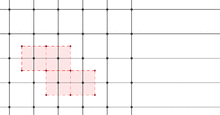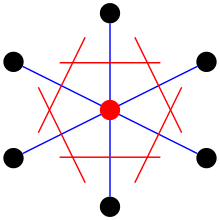Wigner–Seitz cell
The Wigner–Seitz cell, named after Eugene Wigner and Frederick Seitz, is a type of Voronoi cell used in the study of crystalline material in solid-state physics.

The unique property of a crystal is that its atoms are arranged in a regular three-dimensional array called a lattice. All the properties attributed to crystalline materials stem from this highly ordered structure. Such a structure exhibits discrete translational symmetry. In order to model and study such a periodic system, one needs a mathematical "handle" to describe the symmetry and hence draw conclusions about the material properties consequent to this symmetry. The Wigner–Seitz cell is a means to achieve this.
A Wigner–Seitz cell is an example of a primitive cell, which is a unit cell containing exactly one lattice point. It is the locus of points in space that are closer to that lattice point than to any of the other lattice points.
A Wigner–Seitz cell, like any primitive cell, is a fundamental domain for the discete translation symmetry of the lattice. The primitive cell of the reciprocal lattice in momentum space is called the Brillouin zone.
Definition
The Wigner–Seitz cell around a lattice point is defined as the locus of points in space that are closer to that lattice point than to any of the other lattice points.
It can be shown mathematically that a Wigner–Seitz cell is a primitive cell spanning the entire direct space without leaving any gaps or holes.
The Wigner–Seitz cell in the reciprocal space is known as the first Brillouin zone. It is made by drawing planes normal to the segments joining nearest lattice points to a particular lattice point, through the midpoints of such segments.
Constructing the cell

The cell may be chosen by first picking a lattice point. Then, lines are drawn to all nearby (closest) lattice points. At the midpoint of each line, another line is drawn normal to each of the first set of lines.
In the case of a three-dimensional lattice, a perpendicular plane is drawn at the midpoint of the lines between the lattice points. By using this method, the smallest area (or volume) is enclosed in this way and is called the Wigner–Seitz primitive cell. All area (or space) within the lattice will be filled by this type of primitive cell and will leave no gaps.
General mathematical concept
The general mathematical concept embodied in a Wigner–Seitz cell is more commonly called a Voronoi cell, and the partition of the plane into these cells for a given set of point sites is known as a Voronoi diagram. Though the Wigner–Seitz cell in itself is not of paramount importance in the direct space, it is extremely important in the reciprocal space. The Wigner–Seitz cell in the reciprocal space is called the Brillouin zone, which contains the information about whether a material will be a conductor, semiconductor or an insulator.